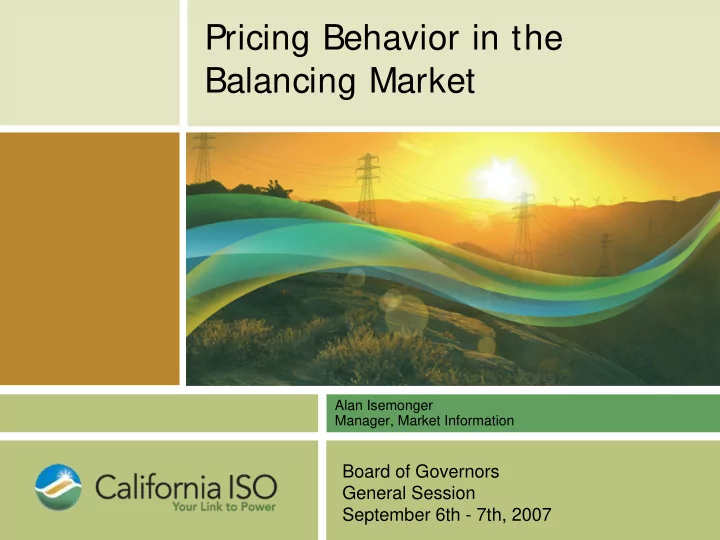

Pricing Behavior in the Balancing Market Alan Isemonger Manager, Market Information Board of Governors General Session September 6th - 7th, 2007
Report History Technical root cause type of report Focuses on legitimacy Legitimacy is multi-faceted A. Market Power B. Software/Modeling/Implementation Issues C. Business Practices Report examines issues related to B and C � Assumes no market power and valid bidding Links legitimacy to avoidability 2
Nature of the Balancing Market Balancing market provides near real time matching between generation and load Balancing energy “fills the gap” between hourly scheduled energy and actual demand Two types: hourly pre-dispatched energy (inter-ties) and 5- minute balancing energy Inter-tie transactions do not set price The most expensive balancing energy dispatched per 5- minute interval sets the market clearing price 3
Balancing Energy Volume The vast majority of energy Balancing Energy Volume as a Percent of consumed in CAISO’s Total Consumption, Feb. 2007 balancing area is bilaterally contracted energy 600000 transacted outside of CAISO CAISO Balancing Market Energy Bilaterally Scheduled Energy markets. 500000 Real Time Balancing Energy 400000 typically constitutes less than 5% of total energy MWh 300000 consumed 200000 Balancing Energy costs are allocated to load deviation 100000 as a pro-rata charge to load deviations from hourly 0 2/1/2007 2/3/2007 2/5/2007 2/7/2007 2/9/2007 2/11/2007 2/13/2007 2/15/2007 2/17/2007 2/19/2007 2/21/2007 2/23/2007 2/25/2007 2/27/2007 schedules Date 4
What is a “Good” Price for Balancing Energy? Balancing Energy prices should accurately reflect the short- term value of energy in a five-minute time frame Balancing Energy scarcity can arise for a number of reasons, including: � Outage of generation or transmission resources � Inherent difficulty in matching day-ahead load forecasts to actual demand � Inability of system resources to respond rapidly enough to changes in system requirements High prices are an appropriate market response to scarcity of Balancing Energy 5
Characterizing Price Events Two types of price Spike Occurrences and Durations by Hour, events: less Aug 2006 – Feb 2007 frequent long duration spikes and 40 10.00 more frequent short duration spikes 36 9.00 Number of Events Avg Intervals per Event Longer, less 32 8.00 frequent price 28 7.00 Number of Occurrences Intervals Per Event events reflect actual 24 6.00 scarcity, tend to 20 5.00 occur at peak load times 16 4.00 Shorter duration 12 3.00 spikes reflect 8 2.00 inability of resources 4 1.00 to rapidly respond to system conditions 0 0.00 1 2 3 4 5 6 7 8 9 10 11 12 13 14 15 16 17 18 19 20 21 22 23 24 and tend to occur at Hour Ending evening ramp times 6
Legitimacy of Price Spikes Longer duration spikes typically indicate an actual shortage due to unavoidable circumstances � Weather deviation from forecast � Outages � Under-scheduling Price elevation is appropriate under these circumstances Shorter Duration spikes indicate short term system scarcity � “Ramp Constraint” – system resources cannot change output instantaneously. � Some of these spikes are appropriate, but some could be mitigated through changes to software, regulatory or market structures 7
Conditions that Create Short Duration Spikes 20-minute ramping creates balancing energy swings Maximum Dec Twenty minute ramp Energy Requirement is a WECC standard for interchange Maximum Inc Energy transactions Requirement Internal generators Balancing Energy use same standard Requirement Experience of Eastern ISOs Minute 30 40 60 10 20 30 50 Total Scheduled Energy Production Actual System Load 8
Ramp Underestimation Current system uses “Look Ahead” with intervals of varying duration Balancing Energy System fails to Requirement account for rapid ramping during the 20-minute schedule change period, Interval 1 Interval 2 Interval 3 leading to price spikes after the 50 55 60 5 10 change of hour Minute Balancing Energy Requirement This issue will be Requirement “Seen” by RTMA mitigated in MRTU 9
Mitigation of Ramp Underestimation in MRTU “Look Ahead” intervals all 5 minute duration MRTU dispatch system gets a more accurate picture of the Balancing Energy Requirement over the inter-hour ramp Dispatch system can Interval 1 Interval 2 Interval 3 Interval 4 Interval 5 Interval 6 optimize system 50 60 5 10 55 response in advance Minute Balancing Energy Requirement to avoid undue price Requirement “Seen” by MRTU elevation 10
Predispatch Declines RTMA models predispatches as binding commitments Many SCs use them as free options This mismatch degrades RTMA’s dispatch optimization as the modeling does not correspond to the way predispatch bids are used High levels of declines during stressed system conditions have contributed to price spikes 11
Conclusions High Balancing Energy prices are appropriate if they reflect a true system scarcity Balancing Energy costs represent a small fraction of the overall cost of energy in CAISO Some price spikes are an appropriate reflection of scarcity, others could be mitigated by changes to systems, tariff, or conventions MRTU will greatly improve the modeling of intertie ramps 12
Recommend
More recommend